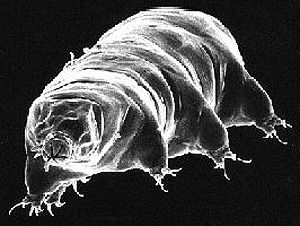-
 Painted lady
Painted lady
-
 Paragenesis
Paragenesis
-
 Lesser kestrel
Lesser kestrel
-
 Subterminal
Subterminal
-
 Aral sea
Aral sea
-
 Mars
Mars
-
 Pyroclastic flow
Pyroclastic flow
-
 Foreshore
Foreshore
-
 Pulmonary plague
Pulmonary plague
-
 Hydraulic energy
Hydraulic energy
-
 Ectropion
Ectropion
-
 Feynman diagrams
Feynman diagrams
-
 Ariel
Ariel
-
 Spleen
Spleen
-
 Shuttering blocks
Shuttering blocks
-
 Pegmatitoid
Pegmatitoid
-
 Zoophage
Zoophage
-
 Wading bird
Wading bird
-
 Internal combustion hydrogen engine
Internal combustion hydrogen engine
-
 WEEE
WEEE
-
 Glass transition
Glass transition
-
 Plant litter
Plant litter
-
 Rheology
Rheology
-
 STI
STI
-
 Magnetar
Magnetar
-
 GSS-API
GSS-API
-
 Prevalence
Prevalence
-
 Stream bed
Stream bed
-
 Frostbite
Frostbite
-
 Speleogenesis
Speleogenesis
Tardigrade
From tardus (slow) and gradi (walk). In English, tardigrades are also called water bears. This is a group of small animals, from 50 micrometres to 1.2 mm, with four pairs of short legs. There are 600 known species, found on land (in the soil) or aquatic (fresh water and sea water) and in all climates.
Several characteristics, including the presence of a cuticle, make them similar to arthropods. Under their current classification, they are panarthropods, alongside Onychophora (Peripatus, worms lined with cuticula that have limbs) and euarthropods (arthropods in their true form, notably insects and crustaceans).
Tardigrades are unique due to their exceptional capacity for survival when they enter into a suspended life state of anhydrobiosis or cryptobiosis. They are thus able to resist:
- temperatures near absolute zero and a maximum temperature of 151°C,
- very long freezing periods (tardigrades collected in glacial (core) samples that have remained there for 2000 years returned to life),
- vacuum,
- a pressure of 600 megapascals (the pressure that would be present at the bottom of a hypothetical ocean 60,000 metres deep),
- exposure to X-rays of 570,000 rads (500 rads is the lethal dose for humans).
According to Russian zoologists, tardigrades were able to survive an excursion into space.

Tardigrade seen by a scanning electron microscope. Credits: Rick Gillis and Roger J. Haro Department of Biology / University of Wisconsin - La Crosse
Latest
Fill out my online form.



